

|
LEM click Released

LEM click carries the LTS 6-NP current transducer and MCP3201 ADC converter. The click can measure AC and DC current with exceptional speed, up to 200 KHz. LEM click is designed to run on either 3.3V or 5V power supply. It communicates with the target microcontroller over SPI interface, or directly with analog output.
|
2017/05/08 |

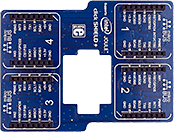
|
Intel® Joule™ click SHIELD + Released

Intel® Joule™ click SHIELD + is an extension for Intel® Joule™ Expansion Board with four mikroBUS™ sockets. This click shield allows you to add more than 280 click boards™ to your project. Add displays, WiFi, ZigBee or Bluetooth transceivers, Ethernet modules, sensors, MP3 codec circuit and other features to your prototype with ease.
|
2017/05/08 |


|
RN4678 click (BlueTooth) Released

RN4678 click carries the RN4678 Bluetooth® 4.2 dual mode module from Microchip, capable of operating as either a BlueTooth Classic or BlueTooth Low Energy device. The click is designed to run on a 3.3V power supply. It communicates with the target microcontroller over I2C and UART interface, with additional functionality provided by the following pins on the mikroBUS™ line: AN, RST, CS, PWM, INT.
|
2017/05/08 |

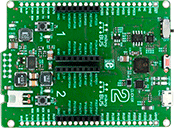
|
clicker 2 for CEC1702 Released

Clicker for CEC1702 is a compact development board with two mikroBUS™ sockets for click board™ connectivity. With more than 270 click boards™ so far, you can combine different functionalities and create without limitations. The board carries the CEC1702, a 32-bit ARM® Cortex™ -M4 Processor Core, with strong cryptographic support.
|
2017/05/08 |


|
CEC1702 clicker Released

CEC1702 clicker is a compact development board with a mikroBUS™ socket for click board connectivity and Microchip's CEC1702 - a 32-bit ARM® Cortex™ -M4 Processor Core, with strong cryptographic support.
|
2017/05/08 |


|
clicker 2 for Kinetis Released

clicker 2 is a battery-powered click board two-seater. NXP's K64 family of microcontrollers are optimized for low power applications, while preserving impressive performance across key specifications such as run power consumption down to 250 µA /MHz, Static power consumption down to 5.8 µA with full state retention and 5 µS wakeup.
|
2017/05/07 |


|
Kinetis clicker Released

Kinetis clicker is an amazingly compact starter development kit which brings click board connectivity an NXP Kinetis microcontroller. Connect the desired click board to enhance it with additional features. It's preprogrammed with a fast USB HID bootloader. Use it to upload your firmware and the clicker will become a working device. The board features all you need to get started: a low power ARM Cortex-M4 32-bit MK22FN512VLH12 microcontroller, a USB connector, two LEDs and push buttons, reset button, mikroProg connector and headers for interfacing with external electronics.
|
2017/05/07 |


|
MINI-M4 for Kinetis Released

MINI-M4 for Kinetis is an ARM® Cortex™-M4 development board containing MK64FN1M0VDC12 microcontroller. This compact and powerful development board is designed to work as a standalone device or as an MCU card in DIP40 socket.
|
2017/05/02 |

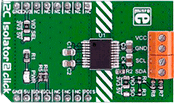
|
I2C Isolator 2 click Released

I2C Isolator 2 click provides I2C lines and power isolation for slave devices. It carries the ADM3260 dual I2C isolator with an integrated DC-to-DC converter. I2C Isolator 2 click is designed to run on either 3.3V or 5V power supply. The click communicates with the target microcontroller over an I2C interface with additional functionality provided by the PWM pin on the mikroBUS™ line.
|
2017/05/02 |


|
4G LTE-NA click (North America) Released

4G LTE-NA click carries the LARA-R204 multi-mode cellular module from u-blox. The board is designed to use 5V power supply. I/O voltage levels could be 3.3V or 5V. It communicates with the target microcontroller over UART interface, with additional functionality provided by the following pins on the mikroBUS™ line: AN, RST, CS, PWM, INT.
|
2017/05/02 |


|
4G LTE-E click (Europe) Released

4G LTE-E click carries the LARA-R211 multi-mode cellular module from u-blox. The board is designed to use 5V power supply. I/O voltage levels could be 3.3V or 5V. It communicates with the target microcontroller over UART interface, with additional functionality provided by the following pins on the mikroBUS™ line: AN, RST, CS, PWM, INT.
|
2017/05/02 |


|
Mic click Released

Mic click carries the SPQ0410HR5H-B surface mount silicon microphone with maximum RF protection. The click is designed to run on a 3.3V power supply. It communicates with the target microcontroller over the AN pin on the mikroBUS™ line.
|
2017/05/02 |


|
GainAMP click Released

GainAMP click carries the LTC®6912 dual channel, low noise, digitally programmable gain amplifier (PGA). The click is designed to work on either 3.3V or 5V power supply. It communicates with the target MCU over SPI interface, with additional functionality provided by the following pins on the mikroBUS™ line: AN, RST.
|
2017/04/23 |


|
GSM/GNSS 2 click Released

GSM/GNSS 2 click combines GPS/GLONASS location tracking with GSM module capability for mobile communication. The click carries SIM868 quad-band GSM/GPRS module.
GSM/GNSS 2 click is designed to run on either 3.3V or 5V power supply. It communicates with the target MCU over UART interface.
|
2017/04/23 |


|
GSM-GNSS click Released

GSM/GNSS click combines GPS/GLONASS location tracking with GSM module capability for mobile communication. The click features Quectel's MC60 quad-band module. GSM/GNSS click runs on either 3.3V or 5V power supply and communicates with the target MCU over UART interface, and the following mikroBUS™ pins: AN, RST, PWM, INT.
|
2017/04/23 |


|
Earthquake click Released

Earthquake click carries D7S, the world's smallest high-precision seismic sensor from Omron. The click is designed to run on either 3.3V or 5V power supply. It communicates with the target MCU over I2C interface, with additional functionality provided by the following pins on the mikroBUS™ line: PWM, INT, CS.
|
2017/04/23 |

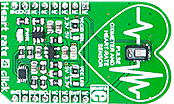
|
Heart rate 4 click Released

Heart rate 4 click carries the MAX30101 high-sensitivity pulse oximeter and heart-rate sensor from Maxim Integrated. The click is designed to run on either 3.3V or 5V power supply. It communicates with the target MCU over I2C interface, with additional functionality provided by INT pin on the mikroBUS™ line.
|
2017/04/23 |

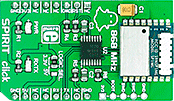
|
SPIRIT click Released

SPIRIT click carries the SP1ML 868MHz ultra low-power RF module. The board is designed to use 3.3V power supply and 3.3V or 5V I/O voltage levels. It communicates with the target MCU over UART interface, with additional functionality provided by the following pins on the mikroBUS™ line: PWM, RST, CS.
|
2017/04/23 |

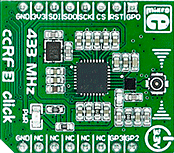
|
ccRF 3 click Released

ccRF 3 click carries the CC1120 high-performance RF transceiver for narrowband systems from Texas Instruments. The clicks will enable you to add a low-power consumption radio transceiver at 433 MHz frequency. ccRF 3 click is designed to run on a 3.3V power supply. It communicates with the target microcontroller over SPI interface.
|
2017/04/23 |


|
MIC24045 click Released

MIC24045 click carries MIC24045 I2C-programmable, high-efficiency, wide input range, 5A synchronous step-down regulator from Microchip. The click is designed to run on either 3.3V or 5V power supply. It communicates with the target microcontroller over I2C interface with additional functionality provided by the following pins on the mikroBUS™ line: RST, INT.
|
2017/04/23 |

|

